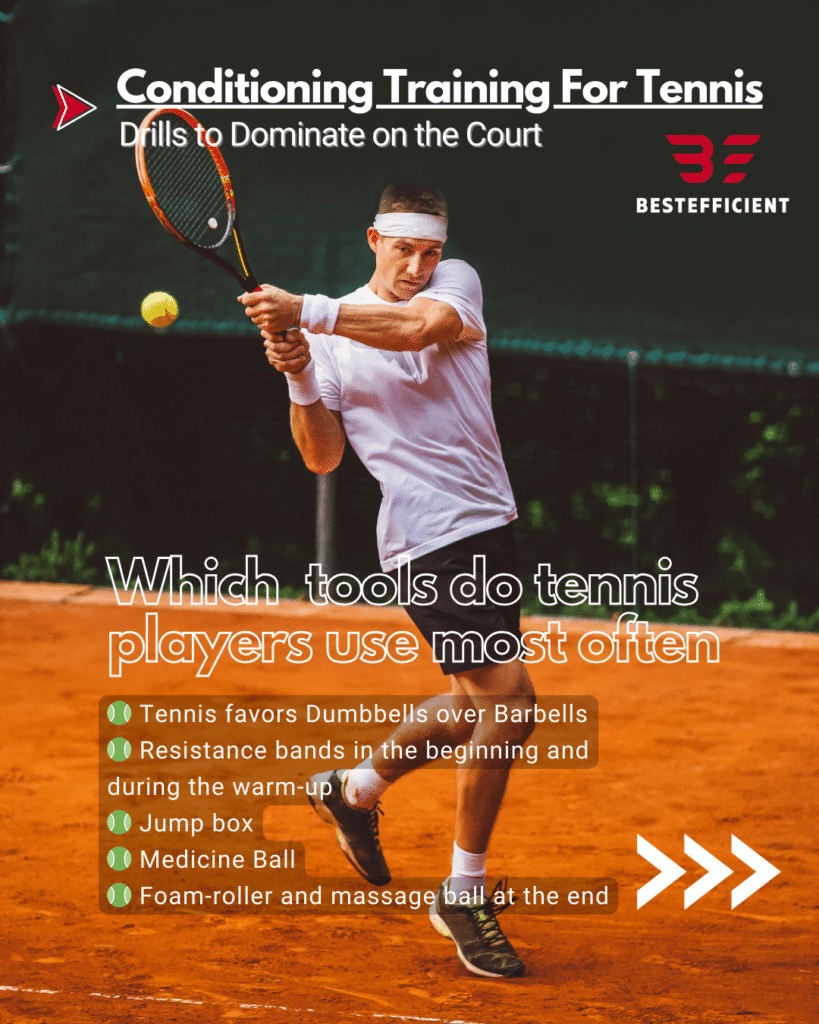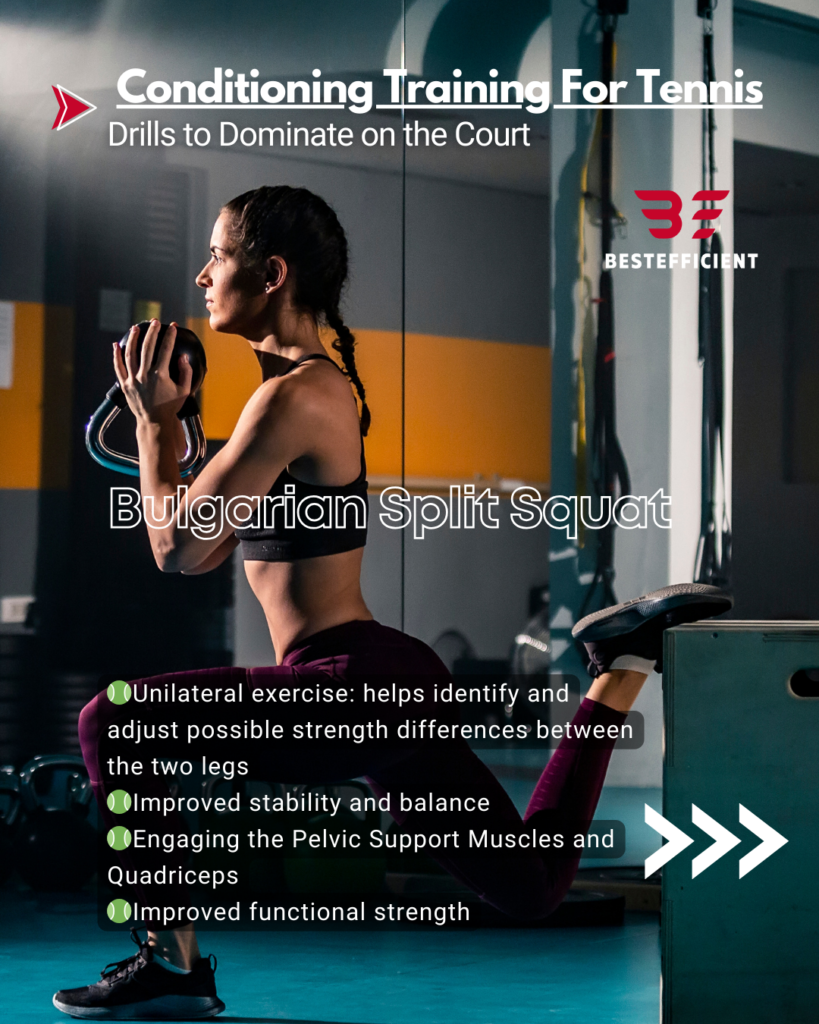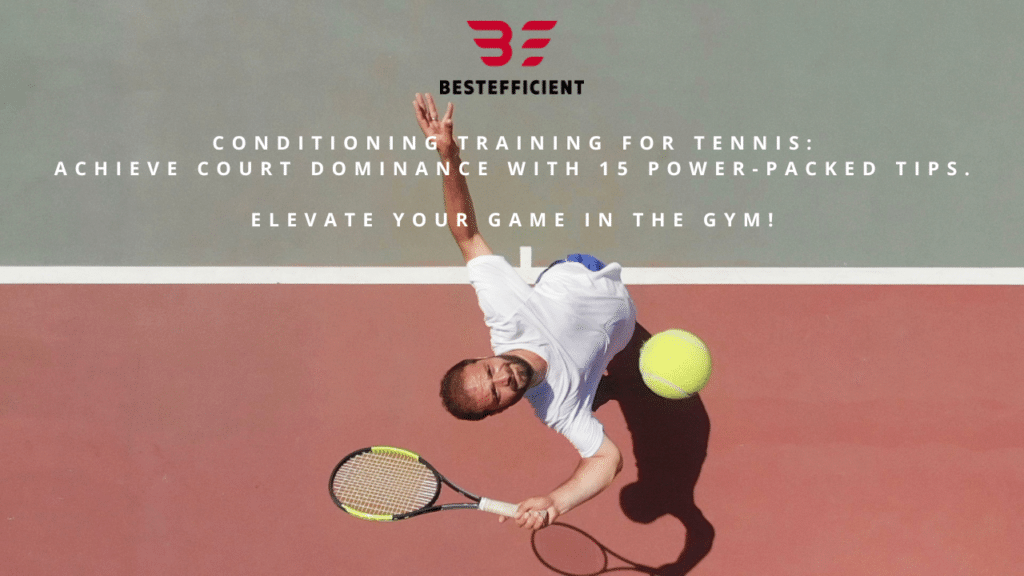Conditioning Training for Tennis is the key to embracing the synergy of gym and court work. Unleash your full potential and dominate the game like never before!
Lesson in Conditioning Training for Tennis Players
Why should I play tennis (besides the fact it is great fun)?
It improves cardiovascular health
Tennis is one of the most breathtaking sports, but I must warn you that this is far from just for the spectators. That’s why conditioning training for tennis is more than needed. The dynamics of the sport, the rapid changes of direction and tempo, and the several-hour matches are the basis of making it endlessly interesting for tennis lovers and critically exhausting for those who practice it. At the same time, this rich and varied palette makes it very sought after, not only for viewing but also for playing.
A very socially oriented sport
It can greatly relieve and neutralize mental tension. Although not a team sport, tennis is a sport in which you cannot do without a partner, especially in training. This opens up the possibility of creating lasting friendships related to the love of tennis, but also many contacts and all that just keep you engaged.
The interactions on the court imperceptibly bring a whole range of emotions to the participants, and as I have previously quoted “A man is a man when he plays”, tennis also gives us the opportunity to show and meet that purely human, and at times a little childish essence that each of us keeps within ourselves. Tennis is definitely not just a sport, but also real fun, but also a constant striving to be better.
A workout for the whole body (well, more so for one of the hands)
It manages very well to engage not only the muscles of the legs but also those of the torso, abdominal muscles, and arms. Therefore, in order to really improve your game, weight training, and fitness should be an integral part of your conditioning training for tennis. Although the strokes are delivered by the arm using the racket, their power lies in good footwork and core activation of the torso muscles, so it is right to say that through tennis we engage the majority of our muscles.
Of course, one hand is under pressure much more than the other, even if we have Djokovic’s two-handed backhand, while if you are a virtuoso like Grigor Dimitrov, then your strong hand will take all the weight of your game.
Develops coordination and agility
Thanks to its dynamic nature, it works excellently on building and improving these two qualities. Tennis is excellent for improving coordination and agility due to its dynamic nature. Players must constantly change their position on the court, track the trajectory of the ball, and perform precise movements to make successful shots.
Tennis is associated with rapid changes in direction of movement, quick reactions, and very precise eye-hand coordination. Additionally, tennis requires a combination of fine motor skills for accurate serves and “heavy artillery” for powerful finishes or forehands, making it an ideal sport for improving overall athleticism, agility, and coordination by implementing the tools of conditioning training for tennis.
So, which equipment/tools do tennis players use most often in the gym?

Resistance bands in the beginning and during the warm-up
They optimally prepare tennis amateurs and professionals alike for abrupt changes of direction, dynamic shots, and optimal pressure of the joints. All of this without risking injury at the start – don’t skip them!
Incorporating resistance bands into conditioning training for tennis is essential for several reasons:
Variable Resistance: resistance bands provide variable resistance, meaning that the level of resistance increases as the elastic is stretched. This mimics the dynamic nature of movements in tennis, where players often encounter varying levels of resistance during actions such as sprinting, changing direction, or hitting the racket.
Sport-Specific Movements: resistance bands allow players to replicate specific movements from the game of tennis with added resistance. This helps train the muscles and joints to cope with the demands of the sport, resulting in improved strength and power in strokes such as serves, smashes, volleys, and other basic shots.
Functional strength: Unlike traditional weightlifting, which can isolate specific muscles, resistance bands encourage the development of functional strength. They engage several muscle groups at the same time, which is better suited to the integrated movements required in tennis. It allows the inclusion of the entire kinematic chain, rather than restricting and isolating one muscle or muscle group.
Improve stability and balance: resistance bands challenge stability and balance, which are essential in playing tennis. Players must maintain stability while moving explosively and changing direction quickly. This helps their improved sense of body movement on the court (proprioception), which in turn reduces the risk of injury and improves the quality of their game.
Increasing flexibility and range of motion: Incorporating resistance bands into stretches helps improve flexibility and range of motion. This is essential for the execution of long-range shots and quick changes of direction that are typical for tennis.
Prevention of sports injuries: By targeting smaller stabilizing muscles, resistance bands help prevent injuries. They help balance muscle development and reduce the risk of overtraining that can occur when certain muscles become proportionally stronger.
Portability and convenience: Elastic bands are lightweight, portable, and versatile. They can be easily carried and used practically anywhere, making them a convenient tool for conditioning training for tennis players, whether they are practicing on the court or on the go.
Personalized Intensity: With a variety of resistance levels, the bands allow for a personalized training experience. Players can gradually progress by using tighter bands or simply gradating the load over the course of their conditioning training for tennis.
Incorporating bands into conditioning training for tennis players helps develop a well-formed athletic foundation that directly translates to improved performance on the court. They are a versatile and effective development tool for players at all levels of tennis.
Foam-roller and massage ball at the end
A great finish to a good game of tennis is to work on flexibility as well as help the recovery process with a foam roller and massage ball (especially for shoulders and arms).
The use of a roller and a massage ball in programs, and conditioning training for tennis players is essential for several reasons:
Myofascial Syndrome Release: The roller and massage ball help release tension in the myofascial tissue that surrounds and supports the muscles. This can relieve muscle tension, improve flexibility, and increase overall mobility, which is important for executing various tennis moves.
Reducing muscle soreness: After intense training or matches, players often experience muscle soreness. The roller and massage ball help relieve this pain by improving blood circulation to the muscles and tissue nutrition, which aids in recovery.
Improve range of motion: By working on specific muscles and fascia, the roller and massage balls help improve joint range of motion. This is especially important in tennis for executing powerful serves, baselines, and volleys.
Improving muscle activation: the foam roller can help and “excite” muscles that may be inactive or inhibited. This is important to ensure that all muscles are functioning properly, which contributes to efficient and powerful movements on the court.
Sports Injury Prevention: Regular use of a roller and massage ball can help identify and work on areas of tension or imbalance before they lead to injury. This proactive approach to injury prevention is especially important in sports such as tennis, which involve fast and dynamic movements.
Improve circulation: Both the foam roller and the massage ball stimulate blood circulation, which helps deliver oxygen and nutrients to the muscles. This will encourage faster recovery, which will contribute to improved performance in subsequent training sessions or matches.
Aiding relaxation and stress relief: The roller and massage ball can and do have a relaxing effect on the nervous system. This can help players relax and reduce stress, which is important for overall performance and mental readiness on the court.
Play with the pressure and therapy zones: Players can control the intensity of the massage by using their personal weight or using different types of massage balls. This allows them to focus on specific areas of tension or discomfort, tailoring therapy to their individual needs.
Cost-effective recovery equipment: The foam roller and massage balls are relatively inexpensive compared to professional massages or other recovery tools. This makes them an economical option for players who wish to incorporate regular recovery practices into their training program.
Include foam roller and massage ball work in your conditioning training for tennis. This will bring you improved muscle function, reduced risk of injury, and improved overall performance on the court. They are an essential part of well-structured fitness training for tennis players at every level.
Jump box in conditioning training for tennis players
It is associated with peak efforts and is a good opportunity to train your explosive power and improve your speed abilities – key qualities in conditioning training for tennis.
Improve your explosive power: Jump box exercises develop quick and dynamic footwork, which is essential for explosive movements in tennis.
Improved vertical jump: Jump box training can increase the height of your vertical jump, which is an advantage for shots such as smashes or volleys. It’s barely needed for you to bounce high up around the court, but it could come in handy for sneaky layups from your opponent.
Improved Agility and Timing: Jumping on and off the Jump box requires good timing and movement control. This improves proprioception, which is the body’s ability to sense its position in space, a quality of utmost importance for any athlete and of particular importance in the conditioning training for tennis players.
Greater legs strength: Engaging the core muscles of the legs contributes to stability, speed, and power in tennis movements.
Benefits of plyometric training: The jump box is a main plyometric leg equipment that improves muscle efficiency for powerful movements on the court. An effective and proven method to improve your speed, power, and explosiveness in terms of conditioning training for tennis.
I do not recommend it for beginners, neither in fitness nor in tennis.
Medicine Balls
They add a lot to the ability to react fast to meeting and playing with the ball by building core strength, obliques, shoulders, and their simultaneous activation.
The medicine ball is a versatile tool for building good conditioning training for tennis. It builds on the plyometric work with the jump box and adds up to its benefits, namely:
Explosive strength and abdominal strength: Incorporating medicine ball exercises will help you develop your explosive strength, especially in twisting movements. It also actively engages the abdominal muscles, which are the basis for power generation on base hits and serves.
Improved coordination and balance: The dynamic nature of medicine ball exercises requires precise coordination and balance. This translates directly onto the court, where players must perform controlled movements while maintaining their stability.
Improved functional strength: Medicine ball exercises simulate tennis movements such as spins, changes of direction, and stances. This improves functional strength, allowing players to execute shots with precision and power.
Plyometric training and speed: Medicine ball exercises incorporate elements of plyometric loading, which improves the stretch-contraction cycle of muscles. This leads to faster and more explosive movements on the court.
Injury prevention and recovery: Controlled medicine ball exercises can help strengthen stabilizing muscles, reducing the risk of classic fitness and tennis injuries. They can be included in rehabilitation programs for players struggling with injuries. The medicine ball is a valuable piece of equipment in conditioning training for tennis players, contributing to the improvement of strength, coordination, functional strength, speed, and injury prevention.
Tennis favors Dumbbells over Barbells
The use of dumbbells in the conditioning training for tennis players offers specific advantages over barbells and is a direct bridge between fitness and tennis:
Greater range of motion: Dumbbells allow a greater range of motion compared to barbells. This is essential for tennis players as it allows them to simulate the natural movements and positions required on the court.
Improved Bilateral Symmetry: With dumbbells, each arm works independently, which helps correct any differences in strength between the dominant and non-dominant arms. This promotes better overall symmetry and reduces the risk of injury associated with compensatory movements.
Greater involvement of stabilizing muscles: Dumbbell exercises require greater involvement of stabilizing muscles. This contributes to improved joint stability and proprioception, which are essential for the execution of precise and controlled movements during a match.
Versatility and functional training: Dumbbells allow for a wide range of exercises that can simulate tennis movements. This facilitates functional training where players can target specifically the muscle groups and movements required for their sport.
Reducing the risk of overload and injury: Bars can sometimes direct the body’s movement into fixed positions, which can lead to overload and injury. Dumbbells, on the other hand, provide greater flexibility that allows for movements better suited to individual biomechanics.
In summary, incorporating dumbbells into conditioning training for tennis can lead to improved range of motion, balanced strength, better stability, and reduced risk of strain and injury.
These are universal and effective tools for adapting fitness workouts to the specific needs of conditioning training for tennis players.
What exercises should I do in my conditioning training for tennis to dominate on the court?
Side Lunges on a Slider or With a resistance band
Emphasis on lateral movements: Side lunges emphasize lateral (side-to-side) movements, which are essential in tennis for quick changes of direction and reaching difficult balls.
Pelvic Mobility and Stability: Performing side lunges requires a wide range of motion in the pelvis, which promotes flexibility and stability. This is essential for hitting powerful shots and maintaining proper court position.
Abductor Tightening: Engaging the abductors contributes to the activation and stabilization, which is essential for stabilizing the pelvis and controlling leg movements. This helps prevent injuries associated with misaligned hip and knee joints.
Balance and coordination challenge: Sideline lunges, especially with rubber bands or slide pads, improve balance and synchronization in the kinematic chain, which is vital for stability during dynamic movements on the court.
Activation of the obliques: Side lunges also activate the obliques, which support the rotational movements essential to tennis serves and backstrokes.
By incorporating side lunges, especially with added resistance by bands or slide pads, tennis players can focus on lateral movement, improve hip mobility, strengthen key muscle groups, and improve balance and coordination. These exercises are tailored to meet the specific demands of the sport. These points highlight the specific benefits of incorporating side lunges, especially with added resistance, into your conditioning training for tennis.
Single-leg Squat/ Bulgarian Split Squat

Unilateral exercise: The Bulgarian Split Squat focuses on one leg under load, which helps identify and adjust possible strength differences between the two legs. This promotes more even strength development and reduces the risk of overexertion.
Improved stability and balance: Performing the Bulgarian Split Squat requires significant stability and balance, especially with added resistance. This could translate directly into a benefit on the court, where players must maintain stability during dynamic movements.
Engaging the Pelvic Support Muscles and Quadriceps: Bulgarian Split Squats engage the pelvic support muscles and quadriceps, which are essential for movements such as lunges, reaching the ball, and quickly changing direction on the court.
Improved functional strength: This exercise mimics the leg movements required in tennis, such as lunging forward to reach a ball. It improves functional strength, making it easier to perform powerful and accurate strokes.
All these specifics greatly benefit the role of Bulgarian Split Squat in conditioning training for tennis players.
(TOP) Twist with Cable on a Pulley a.k.a. “Woodchopper”
Rotational Strength: The “Woodchopper” exercise engages the abdominal muscles and upper body in a rotational movement that simulates the movement of shots such as serves and forehands in tennis. This exercise helps develop rotational strength, which is essential for powerful yet accurate shots. It’s just a piece of art in terms of conditioning training for tennis players.
Stability and Balance: Performing the “Woodchopper” requires stability and balance, especially when resisting the weight attached to the pulley or rubber band. This is essential for maintaining control during dynamic movements on the court.
Abdominal strength and endurance: The exercise activates the abdominal muscles, including the lateral abdominal muscles, helping to generate power and stabilize the torso during various tennis movements.
Functional Motor Pattern: The “Woodchopper” movement resembles movements that occur in tennis, such as the rotation of the torso in preparation for a shot. These movements are essential in the conditioning of tennis players because they complete the transition between fitness and conditioning training for tennis, transferring efforts in the gym to performance on the court. This exercise improves functional strength by making it easier to execute powerful forehands and backhands with precision.
Resistance Included: Using a pulley provides the ability to adjust the resistance, allowing players to gradually increase the resistance. This helps develop strength and power specific to the demands of tennis.
Russian Twists
The „Russian Twist“ is an effective exercise in fitness and tennis training with several important benefits:
Abdominal strength and stability: The Russian twist targets the core of the torso muscles, especially the lateral abdominal muscles. This helps improve rotational strength, which is essential for power generation in tennis strokes.
Improved Rotational Mobility: Tennis players often need to make quick turns to get into a comfortable playing position and/or to hit the tennis ball with the necessary power and precision. The Russian twists helps increase rotational mobility in the core and abdominals, allowing players to execute powerful shots with greater ease. Which is one of the main priorities of conditioning training for tennis.
Improved Balance and Timing: This exercise challenges the balance and timing that are vital to maintaining stability during dynamic movements on the court.
Targeted Involvement of Lateral/ Oblique Abdominal Muscles: The Russian Twist specifically engages the lateral abdominal muscles, which play an important role in controlling and stabilizing movements during a match.
Added resistance: Picking up a weight or medicine ball in the Russian Twist will add resistance, further strengthening the abdominal muscles and simulating the strain of a tennis match.
Injury Prevention: A strong core developed through exercises like the Russian Twist can help prevent injuries by providing better support and stability to the back and lower back during high-intensity movements on the court.
The Russian curl is a valuable addition to conditioning training for tennis as it directs strength to the abdominal muscles, improving rotational mobility, balance, and timing. This exercise helps tennis players develop the physical qualities necessary for a powerful and controlled game.
Planks in conditioning training for tennis.:
Stability of abdominal muscles and core: The plank engages the abdominal muscles, aiding in the strength and stability essential for powerful tennis strokes.
Better Posture: Strong abdominal muscles feel for better posture, which is essential for accurate movements on the court.
Reduced risk of lower back and lower back pain: A strong abdomen is a secure protection for the back, reducing the risk of lower back pain, which is a common problem in dynamic sports such as tennis, where there are many changes of direction and the lower back is a vulnerable area.
Improved Endurance: Holding different plank positions for extended periods of time improves muscular endurance, which is essential for maintaining performance during a match, especially during long plays that often reach one minute.
These points highlight specific suggestions for incorporating different types of planks into the conditioning training for tennis players.
Game, set, match – let’s wrap up the benefit of conditioning training for tennis
When we are talking about your performance on the court, conditioning training for tennis is a game-changer. Regardless if you are a devoted professional or an impatient amateur, the positive results will be more than noticeable. You will increase your agility, you will make your core stronger, and you improve your endurance for a more dominant and precise presence on the court.
Moreover, making a priority of this holistic approach to conditioning training for tennis preparation is an investment in your long-term success and well-being as a player. By combining seamlessly fitness and tennis, you are preparing for your future, filled with exciting games and a lot of victories.
For more valuable insights and excellent advice on how to use fitness in a smart and problem-free way to enhance your tennis play, your health, or another priority of yours, do not miss our newsletter. Subscribe today and launch your journey into a healthier, stronger, and more exciting tennis play.
Game, set, and match – let me continue serving all that information and after the play let’s reach new heights leaving the last play to you!

